Physical Address
304 North Cardinal St.
Dorchester Center, MA 02124
Physical Address
304 North Cardinal St.
Dorchester Center, MA 02124
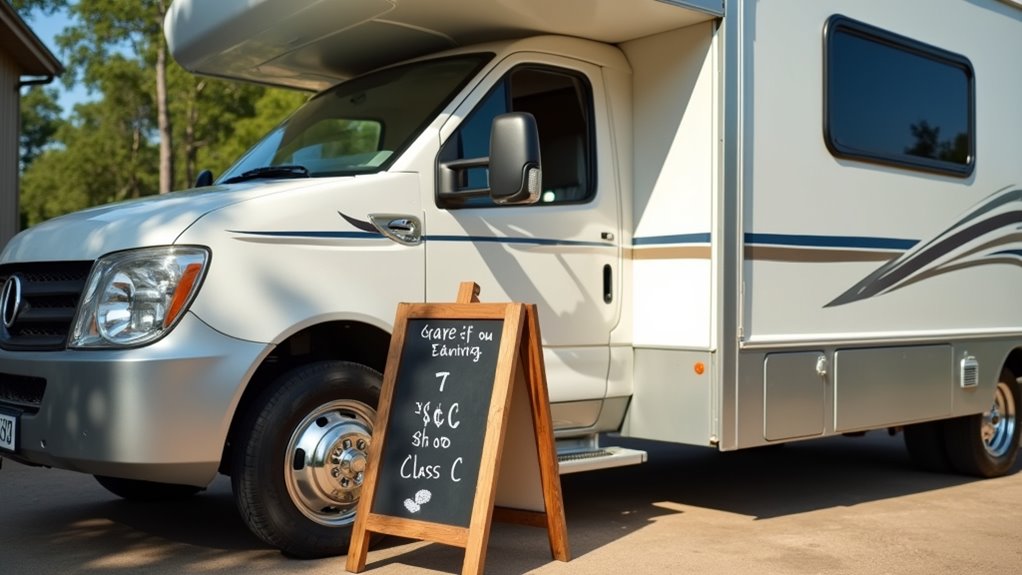
Take a peek behind the glamorous RV rental income claims to discover what experienced owners aren't telling you about the real costs.
Last summer, your neighbor bought an RV for $45,000 and made $12,000 in just three months of renting it out. Stories like this might have you wondering if RV rentals are your ticket to passive income. While the potential profits can be attractive, there’s more to the equation than just listing your rig and collecting checks. You’ll want to understand the complete financial picture, including several hidden costs that could make or break your rental venture.
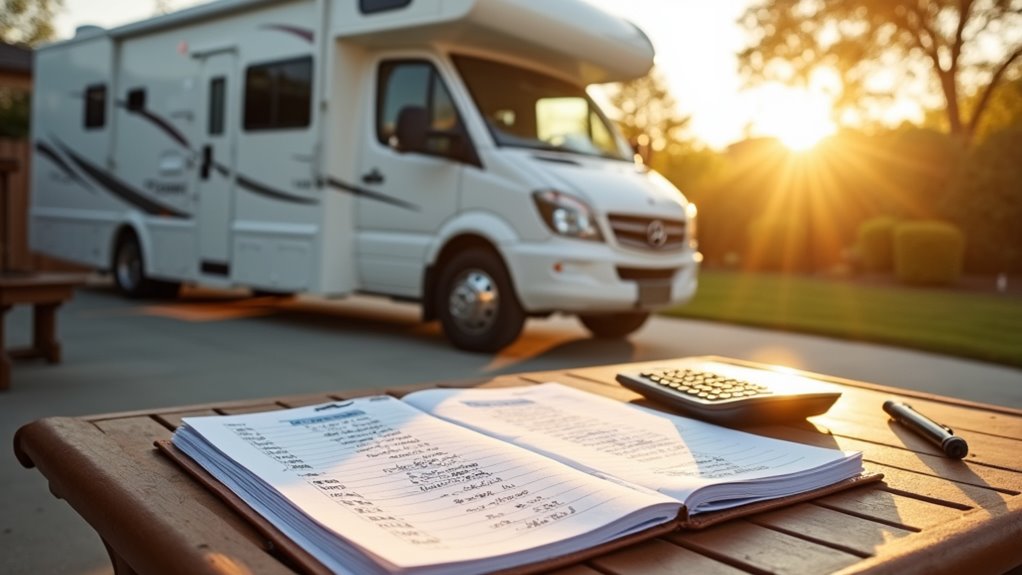
While the RV rental market shows impressive growth projections, let’s cut through the hype and look at what these numbers mean for your potential rental business.
The global market’s expansion, with a 7.4% CAGR through 2030, translates to real opportunities for individual RV owners.
You can expect to charge between $75 to $300 per night, depending on your RV’s size and amenities. These rates fluctuate with seasonal demand, location, and market conditions.
Budget-conscious travelers can often find better deals during off-peak seasons, which affects your pricing strategy throughout the year.
Peak travel seasons will boost your occupancy rates and daily revenue potential. If you’re considering long-term rentals, you’ll benefit from more stable monthly income, though at potentially lower nightly rates.
The surge in outdoor travel, remote work trends, and domestic tourism creates a robust customer base, supporting consistent rental demand throughout the year. Both online and offline rentals show strong market performance, giving you flexibility in how you list and manage your RV rental business.
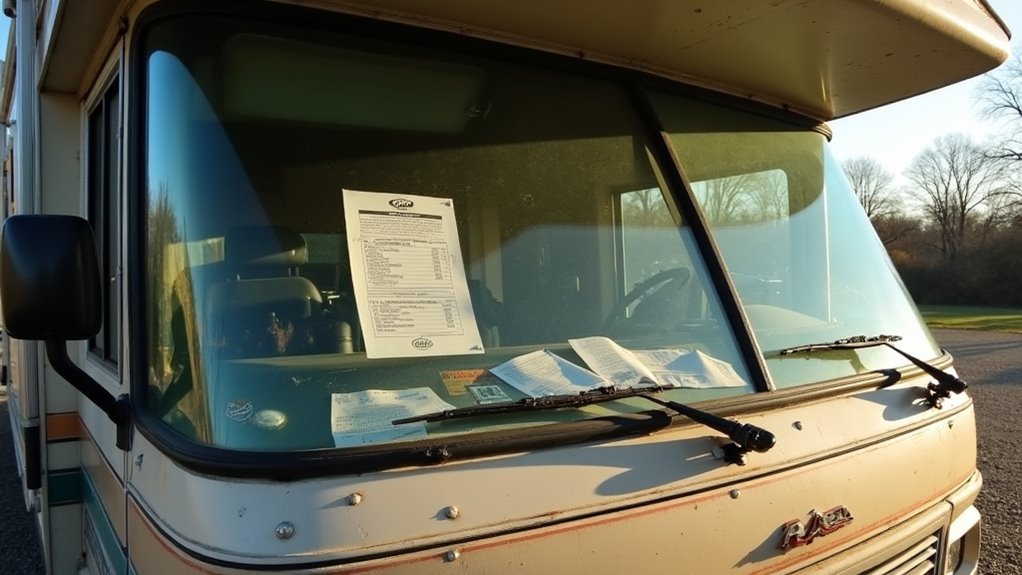
Although the allure of RV rental income is strong, you’ll need to account for numerous hidden expenses that can quickly eat into your profits.
Your fuel costs will surge as renters typically average 10-22 mpg, and you’ll face ongoing maintenance expenses from wear and tear. Many renters need to use RV hookup sites which typically command higher rates than standard campsites. The increasing popularity of RV travel means more competition and potentially lower rental rates to stay competitive.
Insurance premiums can skyrocket after claims, and high deductibles might leave you paying for damage out-of-pocket.
You’ll also encounter unexpected cleaning costs, especially when dealing with smoke, pets, or improperly dumped waste tanks. Professional cleaning services aren’t cheap.
Don’t forget the miscellaneous fees you’ll need to cover: generator usage, propane refills, and replacement of damaged accessories like awnings or bike racks.
Even routine servicing between rentals adds up, making it essential to factor these costs into your rental pricing strategy.
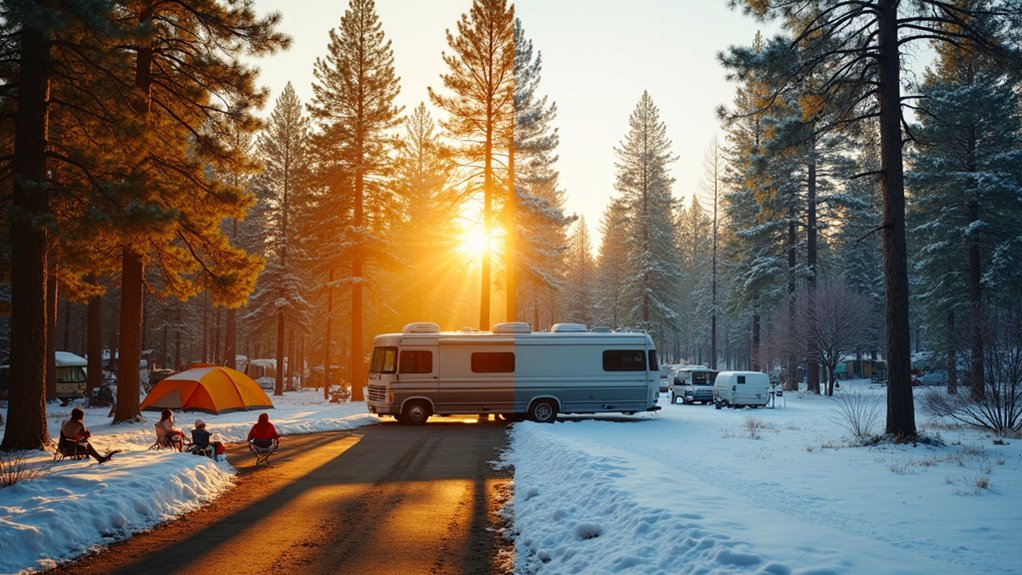
Beyond managing costs, understanding seasonal trends will make or break your RV rental success.
You’ll generate up to 90% of your annual rental income between Memorial Day and Labor Day when families plan their summer vacations. During these peak months, you can command higher rates and enjoy consistent bookings.
Don’t expect the same profits during off-season. Your occupancy rates might drop by 50% or more, especially if you’re in northern regions. Setting your rental prices in the middle price range will help maintain some bookings while staying competitive.
Having a thorough rental checklist ready for each booking will help maximize your efficiency during busy and slow periods alike.
You’ll need to lower your rates and increase marketing efforts to attract renters. Consider offering weekend specials, early-bird discounts, and targeting niche markets like holiday travelers or winter sports enthusiasts.
If you’re in southern states or mild climates, you’ll face less dramatic seasonal swings.
Still, plan your budget around peak season earnings to offset slower months.
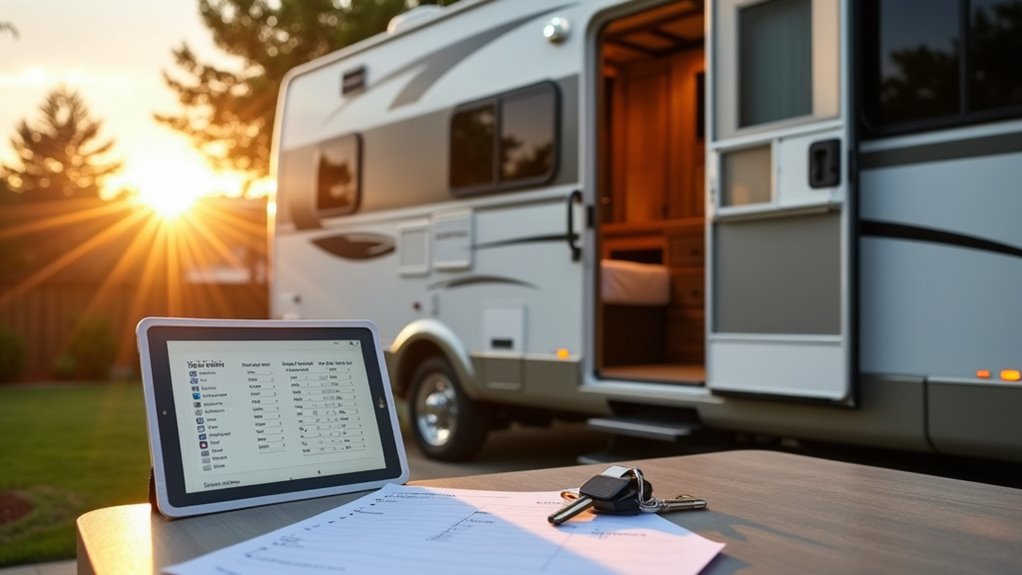
Since maximizing your RV rental income requires a multi-faceted approach, I’ve developed a strategy that consistently delivers strong returns.
Start by creating compelling listings with high-quality photos and detailed descriptions that highlight your RV’s unique features. Setting up listing optimization tools can help automate and improve your rental postings. You’ll want to implement a seasonal pricing calendar, charging premium rates during peak periods while offering strategic discounts during slower times.
Showcase your RV with stunning photos and smart pricing strategies to maximize bookings year-round and stand out from competitors.
Focus on both short and long-term rentals to maintain steady income throughout the year. Consider implementing a loyalty program rewards to encourage repeat bookings from satisfied customers.
Don’t forget to leverage multiple marketing platforms to increase visibility and attract more renters. Set up an efficient booking system and maintain your RV regularly to guarantee positive reviews.
Finally, take advantage of tax benefits by tracking all business-related expenses and applying appropriate deductions – this greatly impacts your bottom line.
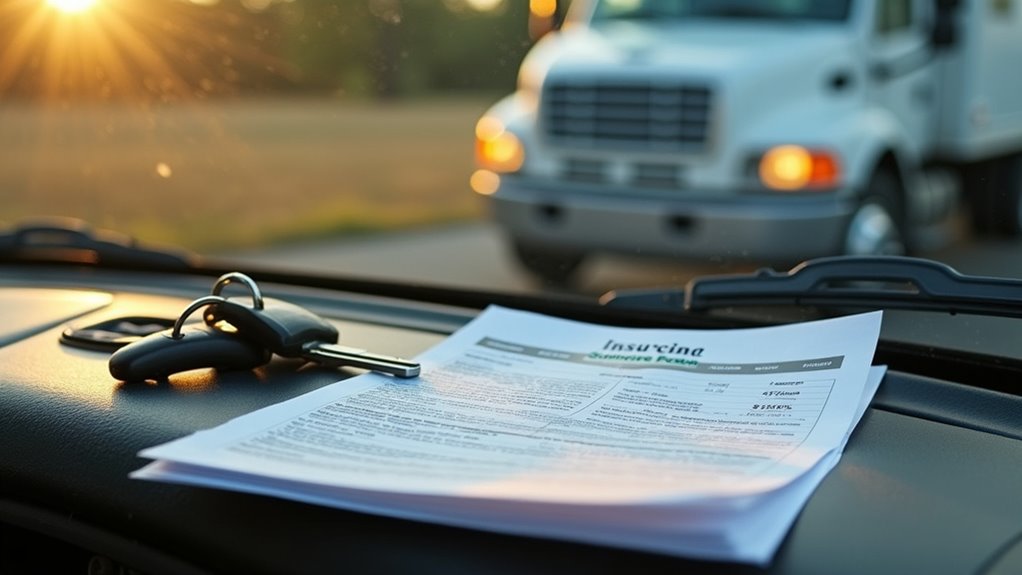
Learning proper insurance coverage became my top priority after a renter damaged my RV’s awning and interior during a storm.
You’ll need extensive coverage of at least $300,000, plus owner liability protection up to $1 million to safeguard against potential lawsuits. Don’t skimp here – even minor repairs can be costly.
You’ll pay between $15-30 daily for insurance, which should include collision, extensive, and campsite liability coverage up to $50,000. Consider using top rental marketplaces like RVshare or Outdoorsy that provide comprehensive insurance packages.
Make sure your policy covers roadside assistance and towing. Choosing a rental platform can help streamline the insurance process and protect both parties. If you’re renting out an older RV (20+ years), you might only qualify for basic liability insurance.
Always verify your coverage meets state requirements and carefully review deductibles.
The most expensive lesson I learned? Having proper insurance is far cheaper than paying out-of-pocket for damages or legal fees.
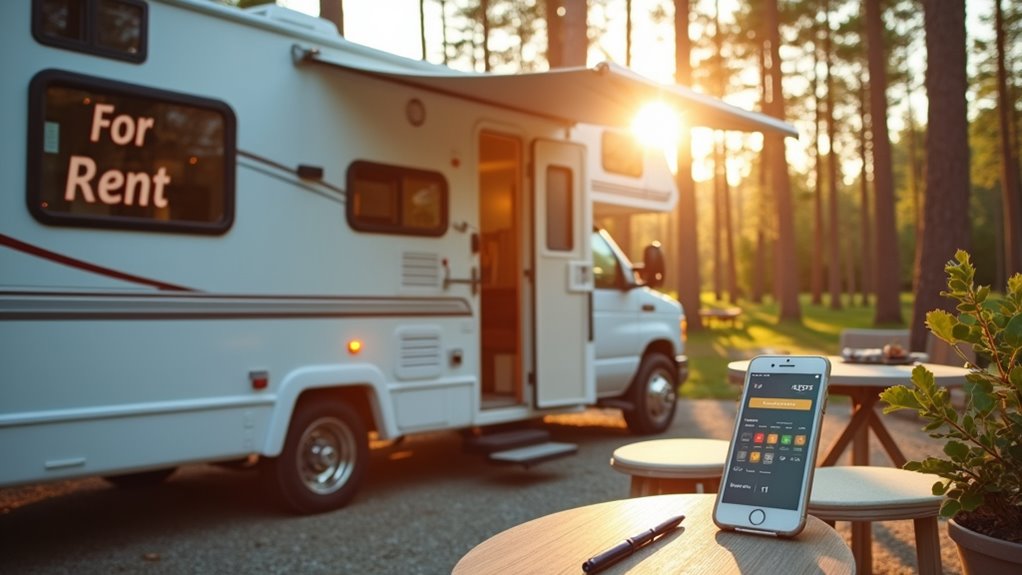
Marketing your RV effectively requires a multi-channel approach that won’t break the bank. Start by listing on established rental platforms like RV Trader, where you’ll reach an active audience of potential renters, even though you’ll pay 18-25% in commission fees. With the RV rental market expected to reach USD 1.29 billion by 2030, investing in proper marketing is crucial for success. Consider using peer-to-peer platforms like RVezy for additional exposure and protection through comprehensive insurance coverage.
Create social media profiles to showcase your RV and build credibility through customer reviews and engaging content.
Consider launching a simple website for direct bookings to reduce platform fees.
During off-peak seasons, use targeted promotions and early-bird discounts to maintain steady bookings while maximizing your rental income.
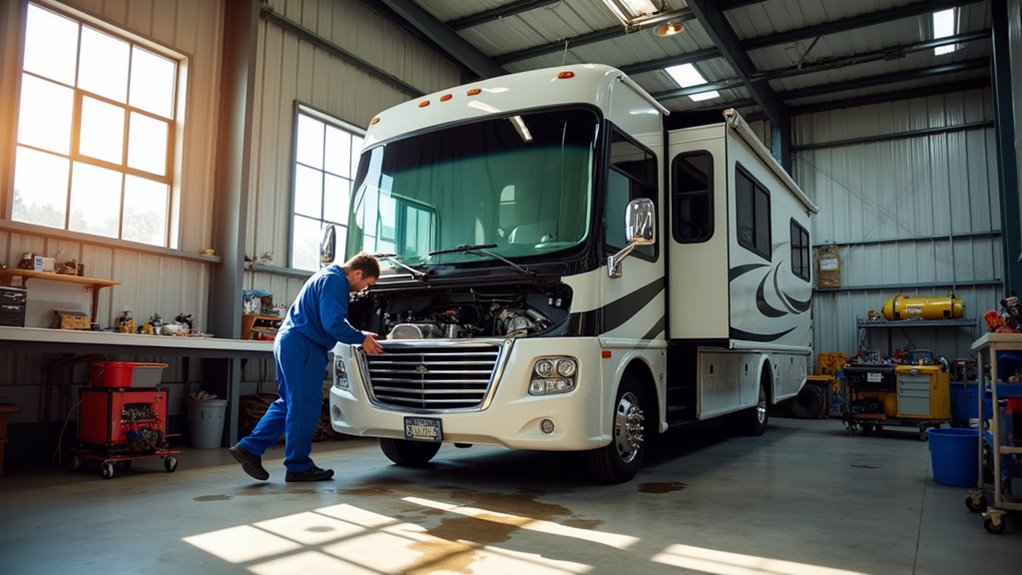
A well-marketed RV needs solid maintenance to back up its appeal. You’ll need to budget between $250 and $500 annually for professional servicing, plus set aside 5-10% of your RV’s value for repairs and maintenance. Over a typical five-year period, expect maintenance costs around $3,400.
Labor costs can hit $160 per hour, so learning basic DIY repairs will save you money. Consider getting an extended warranty to protect against major repair expenses – one study showed $41,250 in repair costs over six years for two RVs. That’s significant. When shopping for used RVs to rent out, always check for existing repairs as they can indicate potential recurring issues.
Don’t skip regular maintenance checks on engines, tires, brakes, and appliances. While it’s tempting to cut corners, prevention is cheaper than repairs.
Create an emergency fund for unexpected issues, and balance DIY fixes with professional help based on your skills. Proper maintenance keeps your RV rental-ready and maximizes your profit potential.

While rental platforms have revolutionized the RV rental market, they’ve also transformed how owners can maximize their profits. These platforms connect you directly with renters, eliminating traditional middlemen and potentially earning you between $7,500 to $30,000 annually. Popular marketplaces like Outdoorsy and RVshare provide comprehensive rental solutions for owners seeking maximum exposure.
This platform-based approach considerably reduces marketing costs while maximizing your rental income potential. With the RV rental market expected to reach $913.08 Million by 2031, platform-based rentals are positioned for substantial growth in the coming years.

Rental platforms make generating income with your RV seem effortless, but understanding the time-to-money ratio is key to determining true profitability.
To earn $20,000 annually, you’ll need to rent your RV for about 114 days, requiring several hours weekly for bookings, preparation, and maintenance.
Generating $20,000 from RV rentals means dedicating over 100 days and countless hours to booking management and upkeep.
You’ll spend 1-2 hours per rental on check-ins and check-outs, plus additional time cleaning, restocking, and handling unexpected issues. Most RV owners only use their vehicles for 19 days yearly, making rental income an attractive option to offset costs.
Many owners choose campsite delivery services to reduce their time commitment and streamline the rental process.
Regular maintenance, administrative tasks, and marketing efforts also demand significant attention. At a 15-20% profit margin, you must consider whether the income justifies the time investment.
Consider this: Your time might be better spent on other income-generating activities.
If you’re spending 10-15 hours weekly managing rentals, calculate your effective hourly rate to determine if it’s worth your effort.

Success in the RV rental business depends on five critical factors that shape your profit potential: market positioning, pricing strategy, operational efficiency, competitive advantage, and customer service excellence.
To maximize your returns in today’s growing market, you’ll need to carefully balance these elements while staying competitive in an industry projected to reach $1.29 billion by 2030.
The freedom of mobility that RVs offer makes them increasingly attractive to adventure-seeking travelers.
Your success hinges on maintaining operational efficiency while meeting customer expectations in a market growing at 8.11% annually. Understanding the current low market concentration creates opportunities for new entrants to establish themselves in this highly fragmented industry.
Like tending a garden, your RV rental business will only flourish with proper care and attention. You’ll need to weather seasonal storms and invest in quality maintenance, but the harvest can be bountiful. If you’re willing to put in the work, track your expenses carefully, and adapt your pricing strategy throughout the year, renting out your RV can grow into a profitable side hustle that pays real dividends.